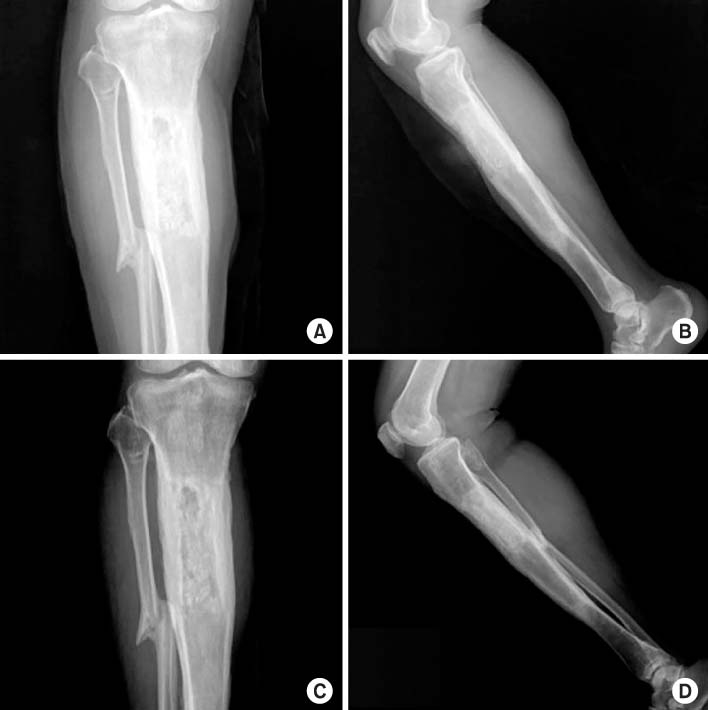J Korean Fract Soc.
2014 Oct;27(4):321-326. 10.12671/jkfs.2014.27.4.321.
Chronic Osteomyelitis in Distraction Osteogenesis Area of Tibial Shaft: A Case Report
- Affiliations
-
- 1Department of Orthopedic Surgery, College of Medicine, Eulji University, Seoul, Korea. doctorjs@eulji.ac.kr
- KMID: 2015489
- DOI: http://doi.org/10.12671/jkfs.2014.27.4.321
Abstract
- Distraction osteogenesis with an Ilizarov external fixator is one of the most successful treatment options for large segmental bone defects after extensive debridement of chronic osteomyelitis in the tibial shaft. Its complications include skin irritation, pin tract infection, and non-union due to infection. There are few case reports on chronic osteomyelitis occurring in the distraction osteogenesis area. The authors experienced a chronic osteomyelitis in the distraction osteogenesis area of the tibial shaft and report this case with references.
Figure
Reference
-
1. Liu T, Zhang X, Li Z, Peng D. Management of combined bone defect and limb-length discrepancy after tibial chronic osteomyelitis. Orthopedics. 2011; 34:e363–e367.
Article2. Magadum MP, Basavaraj Yadav CM, Phaneesha MS, Ramesh LJ. Acute compression and lengthening by the Ilizarov technique for infected nonunion of the tibia with large bone defects. J Orthop Surg (Hong Kong). 2006; 14:273–279.
Article3. Cierny G 3rd, Zorn KE. Segmental tibial defects. Comparing conventional and Ilizarov methodologies. Clin Orthop Relat Res. 1994; (301):118–123.4. Gateley DR, Irby SJ, Martin DL, Simonis RB. Ilizarov bone transport for the treatment of chronic osteomyelitis: a rare complication. J R Soc Med. 1996; 89:348P–350P.
Article5. Jain AK, Sinha S. Infected nonunion of the long bones. Clin Orthop Relat Res. 2005; (431):57–65.
Article6. Song HR, Kale A, Park HB, et al. Comparison of internal bone transport and vascularized fibular grafting for femoral bone defects. J Orthop Trauma. 2003; 17:203–211.
Article7. Uçkay I, Assal M, Legout L, et al. Recurrent osteomyelitis caused by infection with different bacterial strains without obvious source of reinfection. J Clin Microbiol. 2006; 44:1194–1196.
Article8. Jorge LS, Chueire AG, Rossit AR. Osteomyelitis: a current challenge. Braz J Infect Dis. 2010; 14:310–315.
Article9. Brady RA, Leid JG, Calhoun JH, Costerton JW, Shirtliff ME. Osteomyelitis and the role of biofilms in chronic infection. FEMS Immunol Med Microbiol. 2008; 52:13–22.
Article
- Full Text Links
- Actions
-
Cited
- CITED
-
- Close
- Share
- Similar articles
-
- Case reports of antero-posteior movement with distraction osteogenesis in maxillary anterior segment
- Healing of the Bony Gap with Periosteal Osteogenesis After Tibial Diaphysectomy in Adult: Report of A Case
- Distraction osteogenesis in facial asymmetry patient
- Successful Removal of 30 Years Indwelled Brooker-Wills Tibial Nail without Breaking Distal Metal Fins: A Case Report
- Multiple Brachymetacarpia Treated by Distraction Osteogenesis






